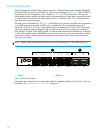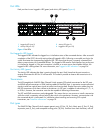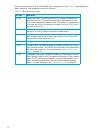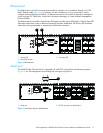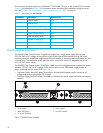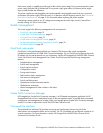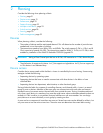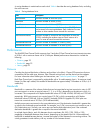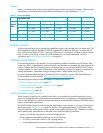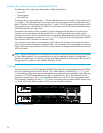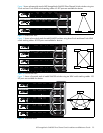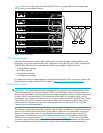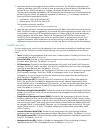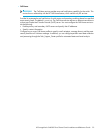
22
A zoning database is maintained on each switch. Table 4 describes the zoning database limits, excluding
the active zone set.
Performance
The SN6000 Fibre Channel Switch supports class 2 and class 3 Fibre Channel service at transmission rates
of 8 Gb/s with a maximum frame size of 2,148 bytes. Related performance characteristics include the
following:
• Distance, page 22
• Bandwidth, page 22
• Latency, page 23
Distance
Consider the physical distribution of devices and switches in the fabric. Choose SFP transceivers that are
compatible with the cable type, distance, Fibre Channel revision level, and the device host bus adapter.
For more information about cable types and transceivers, see ”Technical specifications” on page 71.
Each Fibre Channel port is supported by a data buffer with a 16 credit capacity; that is, 16 maximum sized
frames. For fibre optic cables, this enables full bandwidth over approximately 3 kilometers at 8 Gb/s (4.8
credits/km).
Bandwidth
Bandwidth is a measure of the volume of data that can be transmitted at a given transmission rate. An SFP
port can transmit or receive at nominal rates of 1, 2, 4, or 8 Gb/s depending on the device to which it is
connected. This corresponds to full duplex bandwidth values of 212 MB, 424 MB, 850 MB, and 1700 MB
respectively. XPAK ports transmit at a nominal rate of 10 Gb/s which corresponds to a full duplex
bandwidth value of 2550 MB. With an SN6000 Stackable 20Gb ISL Upgrade LTU, XPAK ports can
transmit at a nominal rate of 20 Gb/s (5100 MB bandwidth)
Multiple source ports can transmit to the same destination port if the destination bandwidth is greater than
or equal to the combined source bandwidth. For example, two 2 Gb/s source ports can transmit to one 4
Gb/s destination port. Similarly, one source port can feed multiple destination ports if the combined
destination bandwidth is greater than or equal to the source bandwidth.
In multiple chassis fabrics, each link between chassis contributes 424, 850, 1700, 2550 or 5100
megabytes of bandwidth between those chassis, depending on the speed of the link. When additional
bandwidth is needed between devices, increase the number of links between the connecting switches. The
switch guarantees in-order delivery with any number of links between chassis.
Table 4 Zoning database limits
Limit Description
MaxZoneSets Maximum number of zone sets (256).
MaxZones Maximum number of zones (2,000).
MaxAliases Maximum number of aliases (2,500).
MaxTotalMembers Maximum number of zone and alias members (10,000) that
can be stored in the zoning database. Each instance of a zone
member or alias member counts toward this maximum.
MaxZonesInZoneSets Maximum number of zones that are components of zone sets
(2,000), excluding the orphan zone set. Each instance of a
zone in a zone set counts toward this maximum.
MaxMembersPerZone Maximum number of members in a zone (2,000).
MaxMembersPerAlias Maximum number of members in an alias (2,000)



